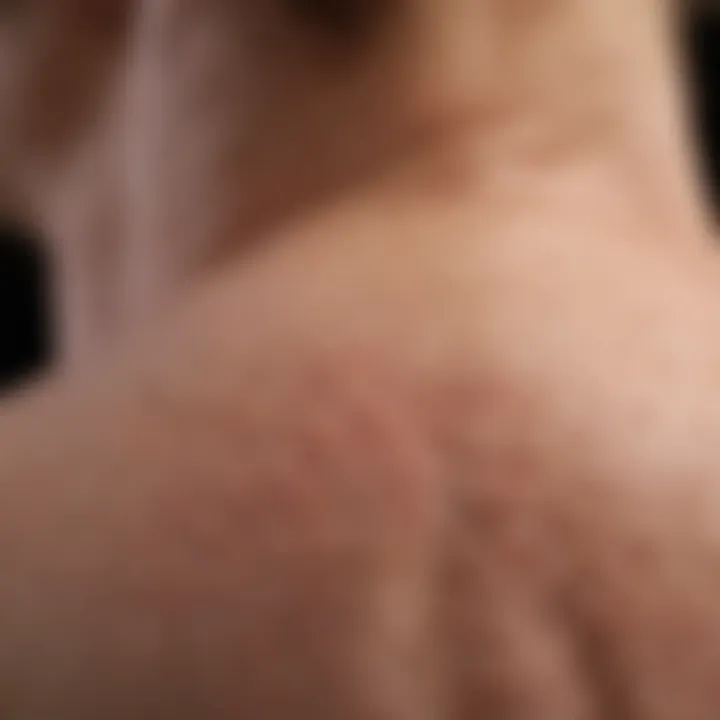Exploring Chronic Hives: Symptoms, Causes & Management


Intro
Chronic hives, or chronic urticaria, is a persistent skin disorder that affects many individuals around the globe. Characterized by red, itchy welts that can appear anywhere on the body, this condition can significantly impact quality of life. This article intends to provide a comprehensive examination of chronic hives, including its symptoms, causes, diagnostic approaches, and management strategies.
Understanding chronic hives is vital, not just for patients but for healthcare providers as well. The complexity of this condition makes it essential for both parties to have access to accurate information. Late diagnoses and misconceptions can lead to ineffective treatments, increasing both physical discomfort and psychological distress. Therefore, a thorough exploration is necessary to improve patient outcomes and enhance the understanding surrounding this condition.
Overview of Research Topic
Brief Background and Context
Chronic hives are different from acute urticaria, which is typically brief and linked to specific triggers like food or medication allergies. Those suffering from chronic hives experience symptoms for six weeks or longer. \nThe chronic nature of the disease complicates management efforts, as symptoms can arise without clear triggers.
Importance in Current Scientific Landscape
The study of chronic hives holds significance in current dermatological and immunological fields. Research continues to evolve, contributing to our understanding of the condition's underlying mechanisms. Moreover, the psychological ramifications of chronic hives, including anxiety and depression, warrant ongoing investigation. Understanding symptoms alongside management strategies can bridge gaps in treatment effectiveness and improve patients’ quality of life.
"The multifaceted nature of chronic hives demands a holistic approach in both research and treatment."
Methodology
Research Design and Approach
To understand chronic hives comprehensively, various methodologies are employed. Literature reviews, clinical studies, and patient interviews provide insights into this perplexing condition. Researchers often focus on both quantitative and qualitative data to grasp symptoms better.
Data Collection Techniques
Data is gathered through several techniques, including surveys, clinical trials, and observational studies. Patient self-reports are crucial, as they add first-hand perspectives about symptom severity and triggers. In laboratory settings, biological samples may also be analyzed to explore immune responses linked to chronic hives.
Preface to Chronic Hives
Chronic hives is a significant health issue that impacts quality of life for many individuals. Understanding this condition is crucial not only for those affected but also for healthcare professionals aiming to provide effective treatment. Chronic hives, or chronic urticaria, often presents persistent skin reactions that can remain for six weeks or more. This section will unravel the basic concepts associated with chronic hives, giving a solid foundation for further exploration.
Definition of Chronic Hives
Chronic hives refers to the appearance of itchy welts on the skin that last for an extended period, typically more than six weeks. These welts may vary in size and can change shape or location frequently. The itchiness can be severe, leading to significant discomfort. Unlike acute hives, which may appear suddenly and disappear within days, chronic hives tend to persist, showing a recurring pattern that can be quite frustrating for those who experience it. It is essential to differentiate this from other skin disorders, making an accurate definition vital for patients seeking relief.
Prevalence and Impact
The prevalence of chronic hives varies globally, but it affects approximately 0.5% to 1% of the population. This condition can impact anyone, regardless of age or gender, but it is most commonly seen in young adults. The social and emotional repercussions of chronic hives can be profound. Many individuals report feelings of embarrassment and frustration due to the visible nature of the condition.
Furthermore, chronic hives can significantly disrupt daily activities and sleep patterns, leading to a decreased overall quality of life. For many, this is not just a physical ailment; it encompasses psychological effects as well, such as anxiety and depression. Understanding the prevalence and its impacts provides a broader view that is crucial for addressing the needs of those affected.
Classification of Hives
Understanding the classification of hives is crucial for diagnosing and managing chronic urticaria. Classifying hives helps healthcare providers determine the underlying cause, which is essential for effective treatment. There are primary types of hives, each with distinct characteristics, symptoms, and triggers. The classification influences management strategies and informs patients about their condition. Recognizing the differences between acute and chronic urticaria can lead to better healthcare outcomes and improved patient education.
Acute vs. Chronic Urticaria
Acute urticaria lasts less than six weeks, often linked to a specific trigger such as an allergy. This type may present itself suddenly, requiring immediate attention to alleviate itchy welts. In contrast, chronic urticaria persists for more than six weeks. It can be more complex, as it may not have an identifiable cause. Chronic urticaria leads to emotional distress and can significantly impact daily life. Understanding this distinction is key for appropriate intervention.
Idiopathic Urticaria
Idiopathic urticaria refers to cases where no clear cause can be identified. It accounts for a large percentage of chronic hives cases. Patients may experience frequent outbreaks of welts without an underlying allergic reaction. This unpredictability can make it challenging for patients to manage their symptoms. Healthcare professionals often have to rely on history and symptom patterns to guide treatment. Recognizing idiopathic urticaria is critical as it suggests deeper immunological factors may be at play.
Physical Urticaria
Physical urticaria arises from specific physical stimuli. These stimuli can include pressure, heat, cold, or sunlight. Each type presents unique challenges for diagnosis and management. For example, cold urticaria may cause hives in response to low temperatures, while exercise-induced urticaria occurs following physical exertion. Awareness of these triggers is vital for both patients and providers. Management can vary from avoiding certain activities to medication, depending on the severity and the type of reaction.
Identifying the type of hives can significantly influence treatment plans and improve patient outcomes. Understanding the classification of chronic hives is a fundamental step towards effective management.
Symptoms of Chronic Hives
Understanding the symptoms of chronic hives is crucial for several reasons. Firstly, recognizing these symptoms can lead to a quicker diagnosis and treatment. Many individuals might dismiss the signs, thinking they are just temporary reactions or allergies. Secondly, chronic hives impact not only physical health but also mental wellbeing. Persistent itching and skin irritation can significantly affect the quality of life. Therefore, an informed awareness can empower patients to seek appropriate medical help.


Common Symptoms
Chronic hives are marked by several consistent symptoms:
- Red or Skin-Colored Welts: These usually vary in size and shape. They can appear suddenly and may change location within a short period.
- Intense Itching: One of the most bothersome symptoms, itchiness can lead to scratching, which may cause further skin irritation or injury.
- Swelling: Some individuals may experience angioedema, a deeper form of swelling that can affect the face, lips, or other areas.
- Temperature Sensitivity: Many people report that changes in temperature can provoke hives. Hot showers or cold air may exacerbate the condition.
These symptoms can be sporadic, with episodes lasting from a few minutes to several hours or days. Understanding these common signs can help distinguish chronic hives from other skin conditions.
Differential Diagnosis
When diagnosing chronic hives, it is important to differentiate them from other similar conditions. The following are key considerations in differential diagnosis:
- Allergic Reactions: Immediate allergies typically present with hives, but they are usually short-lived.
- Other Skin Disorders: Conditions like eczema or dermatitis may exhibit similar symptoms but are different in treatment.
- Infectious Causes: Some viral or bacterial infections can mimic hives. A thorough patient history is essential.
- Systemic Conditions: Some autoimmune diseases can lead to similar symptoms, requiring careful evaluation.
It is often beneficial for healthcare professionals to perform a detailed clinical evaluation and possibly employ skin tests or laboratory tests to exclude other causes before confirming a diagnosis of chronic hives.
"The importance of accurate diagnosis in chronic hives cannot be overstated. Misdiagnosis may lead to ineffective treatments and a prolonged suffering for patients."
Overall, a comprehensive understanding of these symptoms and potential differential diagnoses can significantly influence management strategies and improve patient outcomes.
Physiological Mechanisms
Understanding the physiological mechanisms behind chronic hives is crucial for a comprehensive exploration of this condition. These mechanisms influence not only the symptoms experienced by patients but also the underlying causes and potential management strategies. By investigating the intricate interplay between immunological factors and histamine release, it becomes evident how this knowledge can lead to better therapeutic options and improved patient outcomes.
Immunological Factors
The immune system plays a pivotal role in the development and persistence of chronic hives. In many cases, there is an abnormal activation of the immune response. This may be seen in autoimmune disorders where the body mistakenly attacks its own tissues. In the case of chronic urticaria, specific antibodies may react against components of the body, particularly skin cells, leading to the formation of hives. The presence of elevated eosinophils and mast cells in biopsies of affected skin further underscores the significance of these immunological factors.
In addition to autoimmune factors, certain triggers can provoke or exacerbate immune responses. Common culprits include infections, medications, and allergens. Understanding these biological interactions provides a pathway for targeted interventions. Proper identification of these triggers may aid in the development of tailored management plans for individuals.
Histamine Release Mechanisms
Histamine is a key player in the manifestation of hives. Released from mast cells and basophils, histamine causes vasodilation and increased permeability of blood vessels, leading to the characteristic swelling and redness of hives. In chronic hives, this histamine release can occur spontaneously or be triggered by environmental factors, stress, or certain foods.
It is essential to recognize that histamine is just one component of a complex system of mediators involved in inflammation. Other substances like leukotrienes and prostaglandins may also contribute to the symptoms experienced in chronic urticaria. Understanding the specific pathways involved can facilitate more effective treatment approaches, such as the use of antihistamines or other medications that target these pathways.
"An in-depth understanding of physiological mechanisms not only enhances the comprehension of chronic hives but also empowers better management strategies for patients."
By exploring the immunological factors and histamine release mechanisms, researchers and healthcare professionals can strive to improve management strategies. This knowledge ultimately supports a more refined understanding of chronic hives, delivering hope for those affected.
Causes of Chronic Hives
Understanding the causes of chronic hives is essential for effective management and treatment of the condition. Chronic hives, or chronic urticaria, can be triggered by various factors that affect individuals differently. Identifying these triggers is crucial, enabling patients and healthcare providers to develop tailored strategies to alleviate symptoms and improve quality of life. The multifactorial nature of chronic hives means no single cause applies to all sufferers. Thus, a comprehensive view of its causes can lead to better therapeutic outcomes and increased patient understanding.
Autoimmune Disorders
One of the significant causes of chronic hives involves autoimmune disorders. In an autoimmune response, the immune system mistakenly targets the body’s own cells as if they were foreign invaders. Common autoimmune conditions related to chronic hives include lupus and rheumatoid arthritis. For instance, in cases of chronic idiopathic urticaria, the body may produce antibodies that trigger histamine release, leading to the welts and pruritus characteristic of hives. Identifying underlying autoimmune disorders can significantly influence treatment plans, rendering a more holistic approach.
Infections and Allergens
Infections and allergens are also notable causes of chronic hives. Certain viral and bacterial infections can act as triggers, particularly in sensitive individuals. Examples include upper respiratory infections, which often precede or accompany episodes of chronic hives. Allergens, which can provoke the immune response, range from foods like peanuts to environmental triggers such as pollen or dust mites. Understanding these allergens helps patients avoid known triggers and manage outbreaks effectively. Regular consultation with an allergist can provide valuable insights into personal triggers, enhancing preventative strategies.
Environmental Triggers
Environmental triggers play a pivotal role in the onset of chronic hives. These can include temperature changes, sunlight exposure, and even stress. For some individuals, heat or sweating can lead to an exacerbation of symptoms. Cold exposure can have a similar effect, where hives may appear following exposure to cold air or water. Moreover, psychological factors, including stress, have been shown to influence immune response mechanisms. Stress management techniques can, therefore, be integrated into a comprehensive management plan for chronic hives patients.
"Recognizing these environmental factors empowers patients to take control of their condition."
In summary, understanding the causes of chronic hives lays the foundation for tailored management strategies. By exploring autoimmune disorders, infections and allergens, as well as environmental triggers, individuals can work towards reducing the frequency and severity of their symptoms.
Diagnosis of Chronic Hives
The diagnosis of chronic hives is a crucial component in managing this complex condition. It involves identifying the underlying causes of the welts and understanding their chronic nature. Accurate diagnosis can lead to effective treatment options that alleviate symptoms and improve the patient's quality of life. Furthermore, recognizing the distinction between chronic and acute hives is important, as it directs the management approach.


A successful diagnosis not only helps in tracking the progression of the condition but also aids in monitoring potential triggers that exacerbate the symptoms. Professionals highlight that a thorough diagnostic process can uncover hidden factors related to autoimmune disorders, allergens, and other environmental influences.
This section discusses different methodologies in diagnosing chronic hives, with an emphasis on clinical evaluation techniques, skin tests and examinations, and laboratory testing. Each of these components serves as a pillar to establish a complete picture of the patient's condition.
Clinical Evaluation Techniques
Clinical evaluations are fundamental in diagnosing chronic hives. Healthcare practitioners typically start with a comprehensive patient history. This involves asking detailed questions about the onset, duration, and characteristics of the hives. The clinician may inquire about associated symptoms, family history of allergies, and any recent changes in medication or environment.
During physical examination, doctors look for signs that might indicate other underlying conditions such as infections or allergic responses. The evaluation may include determining the severity and frequency of the hives, enabling the doctor to assess the impact on the patient's life. A complete clinical evaluation is vital for differential diagnosis, allowing healthcare providers to distinguish chronic hives from other similar conditions.
Skin Tests and Examinations
Skin tests are another valuable diagnostic tool for chronic hives. In some cases, practitioners may perform specific tests to evaluate potential allergic reactions. Skin prick tests, for instance, can identify sensitivities to common allergens such as pollen, pet dander, or certain foods. During this test, small amounts of allergens are introduced into the skin to monitor for immediate reactions.
Additionally, skin biopsies may be performed if the clinical evaluation raises concern about other dermatological conditions. This examination helps rule out other skin disorders such as dermatitis or vasculitis, which can sometimes mimic chronic hives. The results gleaned from these tests contribute significantly to an accurate diagnosis and informed treatment plan.
Laboratory Testing
Laboratory testing can provide critical insights into diagnosing chronic hives. Blood tests are frequently used to detect underlying autoimmune disorders, such as thyroid disease or systemic lupus erythematosus. A complete blood count (CBC) may also help assess overall health, revealing signs of infection or inflammation.
Specific tests, like checking levels of histamine or eosinophils in the blood, might be indicated depending on the patient's symptoms and history. These tests help determine if the immune system is overly active and involved in the hives' etiology.
Management Strategies for Chronic Hives
Managing chronic hives requires a multifaceted approach, integrating both pharmacological and non-pharmacological strategies. Chronic hives can lead to significant discomfort and can interfere with daily life. Therefore, understanding the management strategies is key for patients and healthcare providers. Effective management can significantly reduce the severity of symptoms and improve the quality of life. Treatment plans should be personalized, considering the unique triggers and responses of each patient.
Pharmacological Treatments
Pharmacological treatments often serve as the first line of defense against chronic hives. Antihistamines are the most commonly prescribed medications. These drugs work by blocking histamine receptors, thus reducing itchiness and swelling. Some notable antihistamines include cetirizine, loratadine, and desloratadine. For more severe cases, healthcare providers may recommend higher doses or prescribe medications like omalizumab, which is particularly effective in patients who do not respond to traditional antihistamines.
Other options include corticosteroids. These drugs can reduce inflammation and suppress the immune response, which may be beneficial in acute flare-ups. However, prolonged use of corticosteroids can lead to side effects, so they are generally recommended for short-term use.
In some situations, leukotriene receptor antagonists may be introduced. These medications can help manage symptoms by targeting another pathway involved in allergic reactions.
It's essential to consult with healthcare professionals before starting any pharmacological treatment to avoid adverse effects or potential interactions with existing medications.
Non-Pharmacological Approaches
Non-pharmacological approaches are equally important in the management of chronic hives. These strategies can complement pharmacological treatments and target underlying triggers to provide better overall relief from symptoms. Lifestyle modifications are a critical component.
- Dietary Adjustments: Identifying and avoiding food triggers can have a significant impact on symptoms. Patients are encouraged to maintain a food diary to track what they eat and how it correlates with the appearance of hives.
- Stress Management: Chronic stress can exacerbate the symptoms of hives. Techniques such as mindfulness, yoga, and meditation can help mitigate stress levels.
- Physical Therapy: In some cases, engaging in regular physical activity can improve circulation and general well-being, which may aid in reducing symptoms.
- Avoidance of Known Triggers: Understanding specific triggers, whether environmental or situational, is crucial. This may involve avoiding certain chemicals, extreme temperatures, or fabrics that irritate the skin.
Employing a comprehensive management plan that includes both pharmacological and non-pharmacological approaches not only enhances symptom control but also supports overall health and well-being in individuals living with chronic hives.
Lifestyle Modifications
Lifestyle modifications play a significant role in managing chronic hives. These adjustments can impact overall well-being and help in reducing the frequency and severity of hives. Patients can adopt various modifications that may alleviate symptoms and improve quality of life. Simple changes in daily routines often result in substantial gains in managing this condition.
Dietary Considerations
Diet can influence how the body reacts to allergens and triggers. Implementing a diet rich in anti-inflammatory foods can be beneficial. Patients are encouraged to include foods such as fruits and vegetables, whole grains, and omega-3 fatty acids—which are found in fish like salmon.
Some individuals with chronic hives may find relief by avoiding specific allergens present in their diet. Common offenders include:
- Nuts: Particularly tree nuts and peanuts.
- Dairy products: Milk, cheese, and yogurt may trigger reactions in some.
- Wheat: Gluten sensitivity might be a cause of skin irritations in certain people.
- Spices: Ingredients like cinnamon and garlic can lead to hives for some.
- Processed foods: Additives and preservatives can also provoke symptoms.
Keeping a food diary may assist in identifying trigger foods. This practice helps individuals correlate dietary intake with hive outbreaks. Consultation with a healthcare professional or a dietitian is advised to develop a balanced diet while managing symptom flare-ups.
Stress Management Techniques
Stress is a known factor that exacerbates many health conditions, including chronic hives. It has a direct effect on the immune system, which can lead to increased histamine release, exacerbating hives. Therefore, implementing stress management techniques can produce tangible benefits.
Finding effective ways to manage stress is crucial. Consider incorporating the following methods:


- Mindfulness and Meditation: Taking time for mindfulness practices can promote relaxation and reduce anxiety levels.
- Regular Exercise: Engaging in physical activity helps release endorphins. This contributes to a general feeling of well-being.
- Breathing Exercises: This technique can help regain control during high-stress moments.
- Yoga: Combining movement with mindfulness can be particularly helpful.
- Adequate Sleep: Prioritizing rest enhances physical resilience against triggers including stress.
"Chronic hives require a multi-faceted approach for management. Lifestyle modifications, alongside medical treatments, provide a balanced strategy to improve outcomes."
Psychological Impact of Chronic Hives
Chronic hives significantly affect not just the skin, but also the emotional and psychological well-being of individuals affected by the condition. The persistent nature of hives, often appearing without warning, can lead to feelings of anxiety and helplessness. Understanding the psychological impact is crucial for an effective overall strategy in managing chronic hives. This section emphasizes the interplay between chronic hives and mental health, outlining both the emotional challenges and available support resources.
Emotional and Mental Health Concerns
Individuals with chronic hives often experience various emotional issues. The visible symptoms, including welts and itching, can lead to embarrassment and social withdrawal. Many suffer from low self-esteem and self-consciousness, which can worsen their mental health.
In some cases, anxiety and depression emerge. For example, the unpredictability of an outbreak may result in constant worry about when the next episode will occur. This heightened state of alertness can lead to irritability, disrupting daily activities and relationships.
Research indicates that people with chronic hives may also face:
- Social Isolation: Fear of judgment may cause individuals to avoid social settings, creating feelings of loneliness.
- Increased Stress Levels: Coping with chronic physical symptoms can be a source of ongoing stress, which in turn may exacerbate the hives.
- Cognitive Impacts: Attention and focus may be compromised, affecting both professional and personal lives.
Recognizing these mental health concerns can lead to better patient care and management strategies. It is thus essential for healthcare providers to address not only the physical symptoms but also the emotional toll chronic hives take on individuals.
Support Resources and Networks
Support networks are vital for individuals managing chronic hives. They offer a space where experiences, coping strategies, and emotional challenges can be shared. This is particularly important given the often isolating effects of the condition.
Resources include:
- Patient Support Groups: Organizations such as the National Alopecia Areata Foundation provide platforms for sharing personal stories and advice. Engaging with others facing similar challenges can reduce feelings of isolation.
- Online Forums: Websites like Reddit have communities where individuals can discuss their experiences with chronic hives. These spaces can provide comfort and practical tips on management.
- Mental Health Services: Professional counseling may help in processing the emotional impact of chronic hives. Therapists can provide strategies to deal with anxiety, stress, and self-esteem issues.
- Educational Resources: Websites like Wikipedia and Britannica can help patients understand their condition better, empowering them to find effective coping strategies.
By accessing support resources and engaging with networks, individuals can mitigate some of the psychological impacts associated with chronic hives. It not only improves their emotional well-being but also enhances their ability to cope with the physical aspects of the condition.
Future Directions in Research
The study of chronic hives, or chronic urticaria, continues to evolve as researchers seek to uncover the underlying complexities of this condition. Future research holds significant importance, as it can lead to better management strategies and enhanced quality of life for patients. Understanding chronic hives involves more than recognizing symptoms; it encompasses exploring the root causes, unique responses to treatment, and the psycho-social aspects of living with this condition. As an area of medical inquiry, the focus on future directions may create pathways for novel therapeutic interventions that specifically target the various physiological mechanisms involved in chronic hives.
Innovative Treatment Approaches
Recent advancements have sparked interest in innovative treatment approaches for chronic hives. Traditional antihistamines remain a cornerstone in symptom management, but ongoing studies are exploring additional options. These include:
- Biologics: Targeted therapies like Omalizumab have shown promise in reducing the severity and frequency of hives. Omalizumab is especially noted for its efficacy in patients who do not respond to standard treatment.
- Immunotherapy: Research is underway on how allergen-specific immunotherapy may play a role in managing chronic hives. This approach could modify the immune response associated with chronic urticaria.
- Combination therapies: Multi-faceted strategies that blend various treatments might prove effective by addressing the diverse symptoms and causes of chronic hives. Such combinations could include both pharmacological and non-pharmacological methods.
Engaging in clinical trials becomes crucial for patients, as these innovative therapies are rigorously tested before becoming widely available. Each study can potentially yield insights that redefine how chronic hives are treated, ultimately leading to more personalized patient care.
Longitudinal Studies and Findings
Longitudinal studies present another vital direction in chronic hives research. By observing patients over extended periods, researchers can gather in-depth data on:
- The natural history of chronic urticaria, including fluctuations in symptoms and overall quality of life.
- The long-term effectiveness of various treatments, helping tailor future therapeutic protocols to improve patient outcomes.
- The identification of biomarkers that may predict responses to different treatments, allowing for customized management based on individual patient profiles.
The insights generated from longitudinal studies can also contribute to a greater understanding of chronic hives as a multifactorial disease. Observing the impact of lifestyle factors, environmental exposures, and comorbidities can inform healthcare providers about the comprehensive management of patients suffering from chronic urticaria.
These focused research efforts will not only enhance clinical practices but also empower patients in their journey towards relief from chronic hives.
Finale
The conclusion of this article serves to reinforce the significance of understanding chronic hives, a complex condition that can deeply affect individuals' lives. This section emphasizes the critical elements discussed throughout the article, providing readers with a concise summary of the key points and reinforcing the benefits of awareness and management strategies.
Chronic hives can be disruptive, causing distress not only due to physical symptoms but also impacting emotional well-being. Addressing these complications necessitates an informed approach both from healthcare providers and patients. The strategies for management discussed earlier highlight the need for a multifaceted approach, combining pharmacological interventions with lifestyle modifications.
In examining the psychological impact often associated with chronic hives, this article stresses the need for adequate support systems. Patients should feel empowered to seek help and resources that can aid their coping mechanisms. Understanding that chronic hives can be interlinked with other health issues is essential for comprehensive treatment.
By synthesizing the information presented, this section underscores the importance of an organized response to chronic hives, encouraging stakeholders to prioritize research and support approaches for affected individuals.
Summary of Key Points
- Chronic hives, or chronic urticaria, presents a persistent skin condition characterized by welts and itchiness.
- It is essential to differentiate between types of hives for accurate diagnosis and treatment.
- Management may involve pharmacological treatments and non-pharmacological strategies, with lifestyle changes playing a critical role.
- The psychological impact of chronic hives can be significant, necessitating support resources.
Call for Continued Research
The ongoing investigation into chronic hives is vital for several reasons. Improved understanding of the underlying causes, particularly in autoimmune responses and environmental triggers, can lead to better diagnostic tools and treatment options. Moreover, long-term studies can shed light on the efficacy of various management strategies.
It is imperative to encourage collaborative efforts among researchers, clinicians, and patients to address gaps in knowledge. Professional communities should emphasize the importance of sharing findings that can aid in the holistic management of chronic hives. Ultimately, continued research holds the promise of advancing the quality of life for those afflicted with this condition.



